(Listen to the radio version here.)
I would make a terrible scientist because I become so emotionally invested in individual people, animals, and places. When a bird I’m observing is a stranger, I can muster some scientific detachment, but if just about any vertebrate animal, be it a chipmunk or a neighborhood crow, makes physical or eye contact, well, I’m a goner.
I of course love all Pileated Woodpeckers, and when I first discovered, in November 2021, that a male Pileated Woodpecker visiting my feeder bore a USF&W leg band, I was thrilled. But I loved him in that general way that I love most cool birds. If he had disappeared after a few visits, I’d have showed off my photos of him wearing that band the way I show off photos of banded Piping Plovers that I’ve never seen again. My heart would hardly feel bruised.
But this banded Pileated stuck around, appearing multiple times every day, and was amazingly tolerant of the many birders gathering in my yard to see my rarity du jour: a Rufous Hummingbird who hung around for a month. I saw and photographed the Pileated so repeatedly that I amassed enough photos to work out the 9-digit band number.
Reporting the number to the Banding Lab, I discovered that he’d been banded by Frank Nicoletti the year before as a first-year bird, meaning he hatched just 2 or 3 months before my grandson Walter was born in 2020. When I started calling him BB (for Banded Boy), well, I was hopelessly in love.
I saw BB in my yard virtually every day that winter, cementing my bond. In April 2022, I photographed him with a female, and didn’t see him much after that. I hoped they were nesting but had no idea where. He started coming regularly in the autumn, and that October, I saw him in the yard a few times with what might have been his own offspring—he was very tolerant of them—but I never saw him feeding them.
In 2023 I know he successfully raised at least four babies because on July 10, he brought a young fledgling daughter to my yard, and a day or two later, he brought two daughters at the same time; soon there was a son, and then two sons at the same time. I was thrilled!
I never saw him with more than two babies at a time, so I presume his mate, covering a different part of our neighborhood, was dealing with the rest of the brood, the whole family gathering near the nest site area at night. When a male and female both stick to their own normal foraging areas as they move about with fledglings, they expose the babies to a wider area and more varied experiences than either parent alone could show them.
Watching any Pileated Woodpeckers caring for young is fascinating; seeing my own BB with his babies threw any scientific detachment out the window. I needed these babies to survive. Of course, as they grew independent and I could no longer recognize them, they became regular old Pileated Woodpeckers. But BB was still my BB!
I had a bilateral mastectomy on December 1, 2023, and BB visited every day when I really needed him—he was the last bird I photographed the day before surgery, the first bird I saw when I came home from the hospital, and the first bird I photographed when I could lift my 5-pound camera a few days after my surgery.
In January 2024, when I saw BB with a female, I assumed she was his mate from the previous year.
I was gone for a while in April, and when I returned at the end of the month, there was a dead Pileated directly below a large horizontal limb of my neighbor’s maple tree where I’ve seen both hawks and owls perched.
The legs were intact and I felt enormous relief that there was no band. The head was missing, suggesting an owl was the killer, but without the head I couldn’t determine the bird’s sex. It could have been one of BB’s young, but in retrospect, I wonder if it hadn’t been his original mate. I saw BB a lot that summer—more than I should have had he been busy with a nest and young. Losing a mate in late April, it would be difficult for him to find a new mate, and a Pileated of either sex would have trouble raising a whole brood as a single parent.
This year all bets were off—BB was here every day during the first half of January, often at the same time as a female and a second male.
Then a Cooper’s Hawk showed up on January 24 and all three Pileateds disappeared. I knew that as an experienced adult living in my neighborhood under Hawk Ridge, BB must have dealt with predators many times, but week after week without any sign of him, it grew increasingly difficult not to fear the worst. It wasn’t until May 31 that I saw him again. I’m always happy to see a Pileated Woodpecker, but my elation this time was orders of magnitude greater.
Throughout June, BB regularly appeared in early morning and before dusk, and, more rarely, once in the middle of the day, a schedule that suggested he was probably nesting. The parents take turns incubating eggs and brooding nestlings, work that burns a lot of calories. The male gets night duty., making a large, filling meal at day’s end and first thing in the morning important. But BB must have been spending the largest part of each day searching for insects to feed those hungry mouths—baby Pileateds weigh almost as much as their parents before they leave the nest.
Pileateds fledge asynchronously, and the parents take turns tending the ones out of the nest and the ones still in the nest. At first the fledglings stay close to home, but as their flying and, especially, their landing skills improve, they follow parents in a widening area. On July 5 when I was photographing baby House Wrens at my neighbor Jeanne’s house, two Pileated Woodpeckers flew in. I managed to get photos of one of them, but with the dense foliage couldn’t see both of them at the same time.
The one I photographed appeared to be a fledgling based on her very dark eyes, but I didn’t get a clear look at the bird accompanying her, presumably one of her parents. I wish I’d seen it better, because BB’s the only adult I’ve seen in and near my yard all summer.
Meanwhile, I’ve been inundated with starlings this year. Even before they took over the Red-headed Woodpecker nest I was following, I let the suet feeder in my backyard go dry—starlings do not need subsidizing. BB’s favorite feeder is in our side yard. I started bringing that one in the house as soon as he had his breakfast, bringing it out again in late afternoon after the starlings left for the day.
But two weeks ago at lunchtime, I glanced out the back window to see BB trying to feed at the empty feeder he seldom visits. I grabbed his favorite feeder, opened the back door, and said, “Hey, BB!” As I carried the feeder to where he expected it, he flew to the boxelder by the driveway, right close to me. He was looking directly at me when I said, “Here you go!” and before I could get into the house, he was pigging out.
The next day, I heard him call from the boxelder by our driveway. I ran downstairs, grabbed the feeder, and ran outside, whistling and calling up to him, and yep—in he flew. Russ was home for lunch and saw the whole thing from the kitchen window. And twice since then, when BB called, I brought out the feeder, and voilà! He must recognize me—if not as a friend, at least as something benign and associated with easy meals.
On July 14, when he showed up about 9:45, he yelled, I brought out the feeder, and WHOA—he wasn’t alone. He’d brought along his daughter! I’d gone back into the house, so I took my first photos of the two of them from the window, him at the feeder and her in a sturdy limb of the boxelder by the driveway, and then of him flying over to feed her.
To get better angles, I went out to the yard. While he was back at the feeder, she flitted to a branch closer to him, but her landing was awkward and she ended up upside-down.
She hung there for a bit, and BB flew over and fed her like that.
When he returned to the feeder again, she toppled, barely managing to right herself before hitting the ground, and flitted to the base of the back boxelder.
She wasn’t very insistent about food from BB—she spent quite a bit of time probing a rotten limb.
Then BB flew to a telephone pole in the back of the yard…
…and then somewhere in back where the vegetation was too thick for me to pick him out, where his daughter quickly joined him. Meanwhile, Lewis Carroll’s Jabberwocky kept popping into my head.
For the duration, I’ll be keeping watch each day, pretending to make scientific observations about Pileated Woodpecker natural history, but I already know two things for certain: this year BB’s nest was successful, and I don’t care if I lack the calm detachment of a scientist. The voice in my brain is still yelling at top volume, “O frabjous day! Callooh! Callay!”


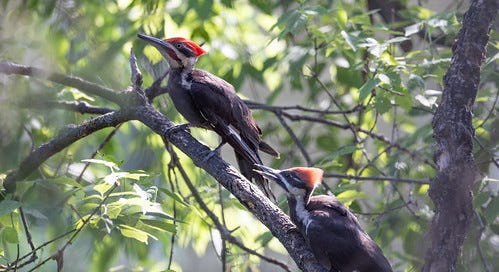



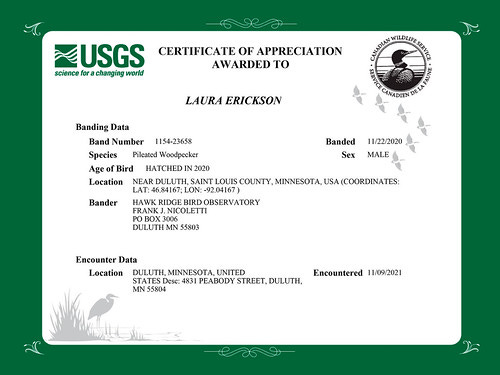
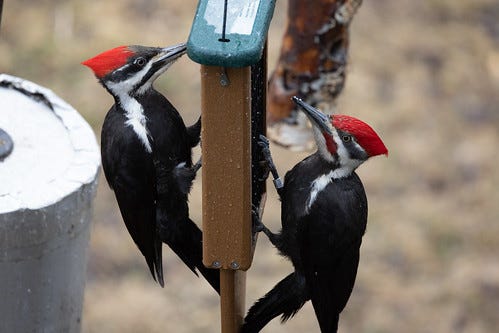
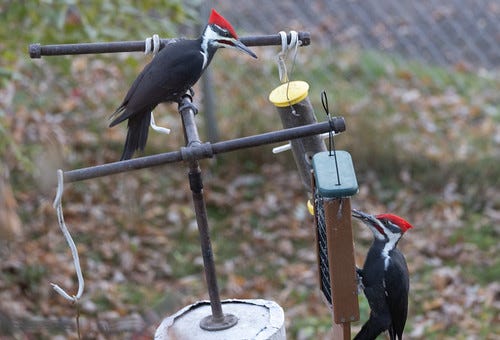
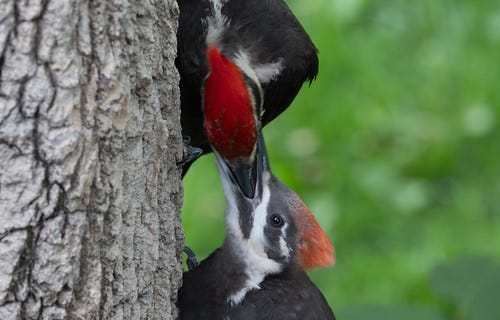



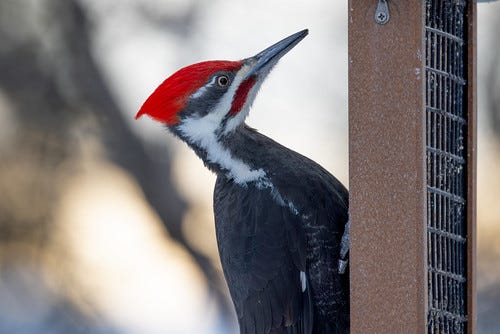


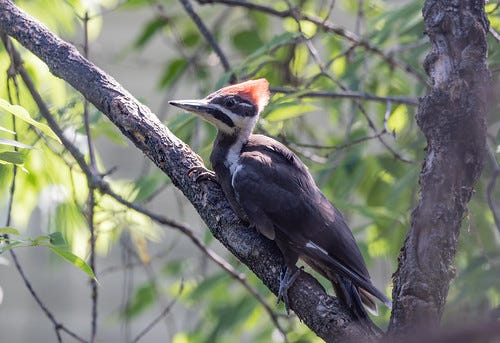
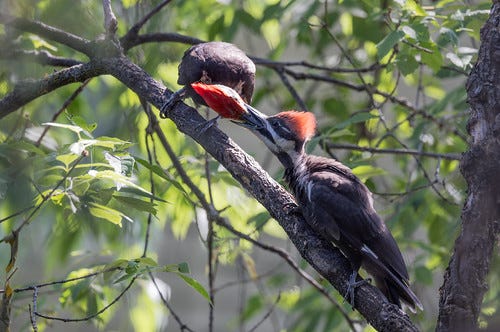
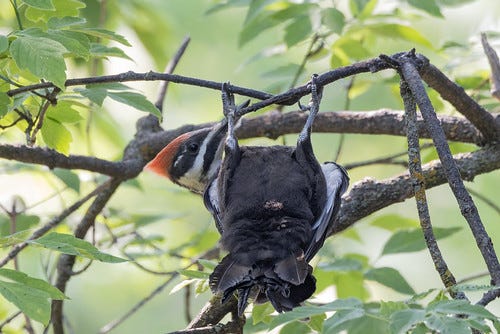

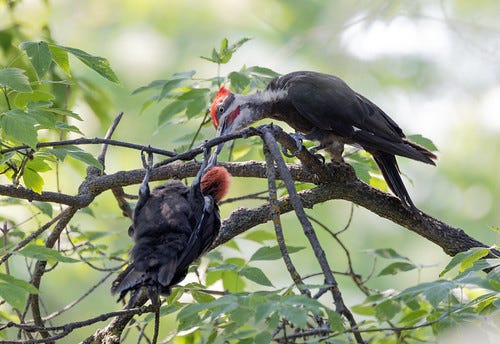

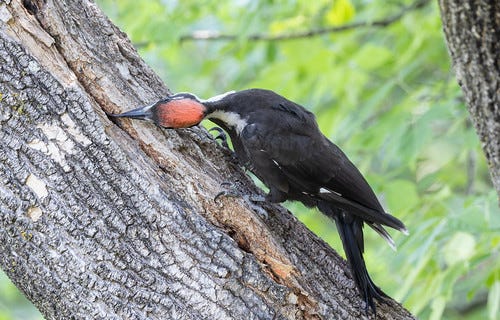

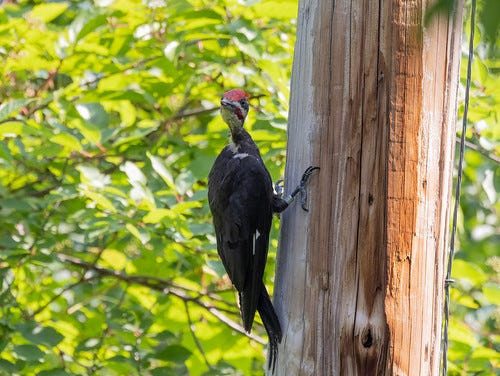

Such a fun article to read. Exhilarating even! Thanks for sharing your joyful story.
This wonderful story had me dancing for joy. I have palliated woodpeckers in my back yard which I celebrate whenever they appear so I completely enjoy your exuberance for this long term relationship.